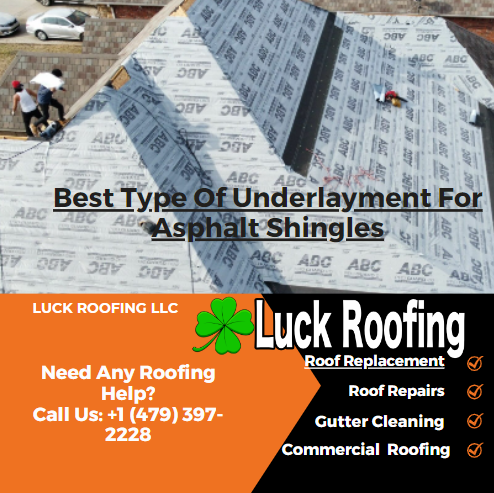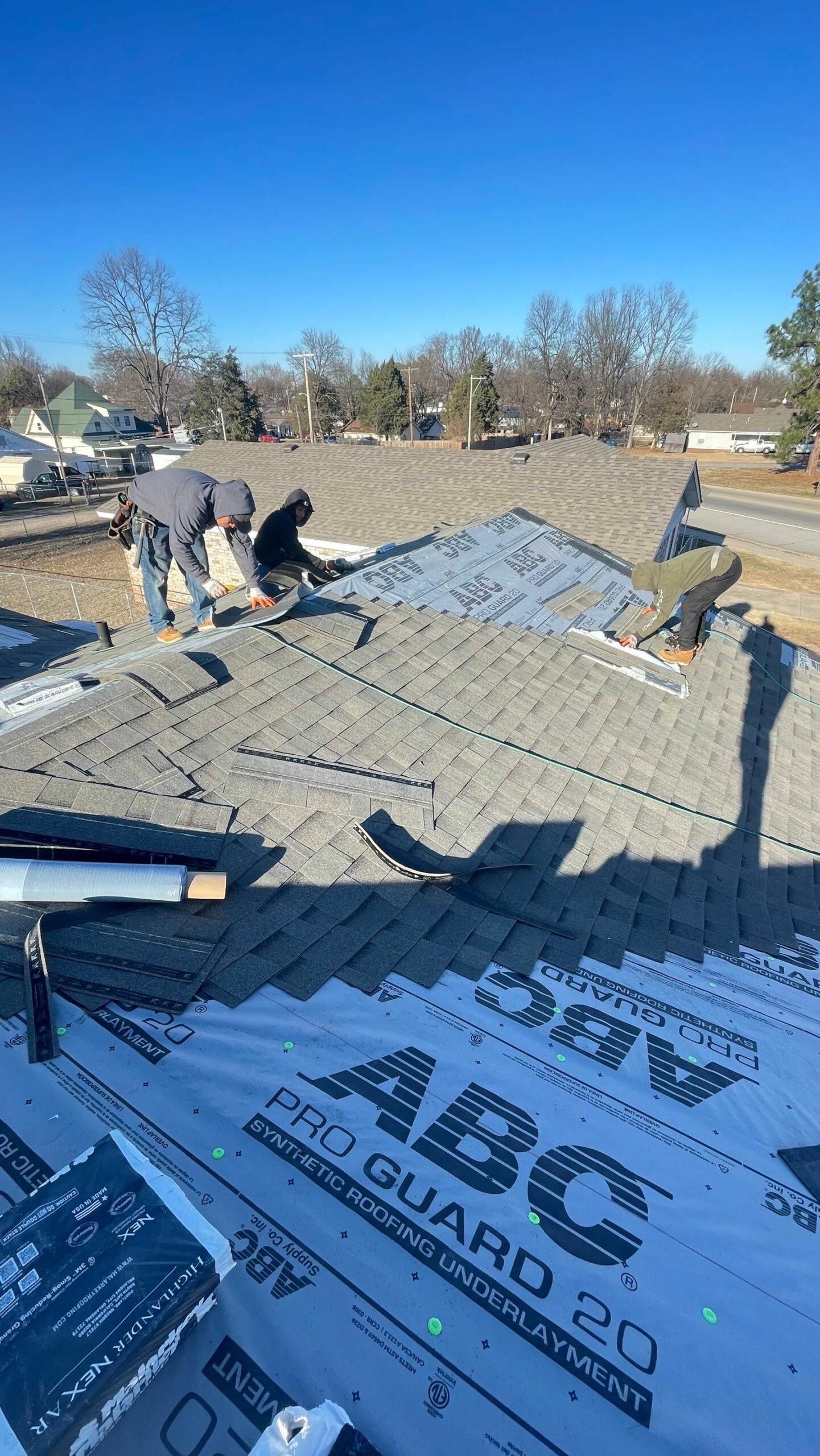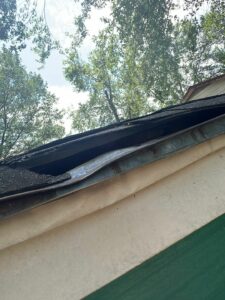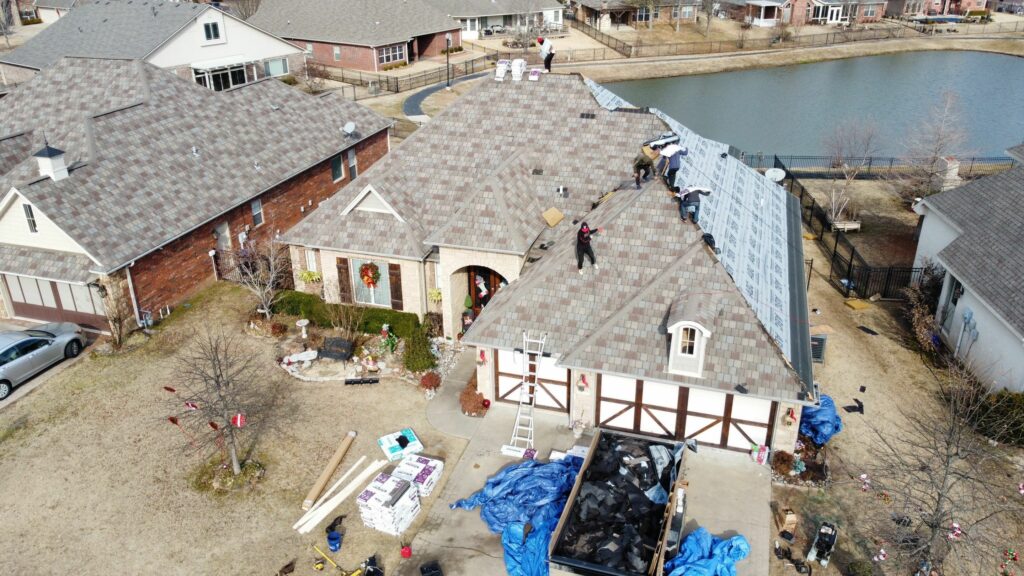
Top Underlayment Selections for Asphalt Shingle Roofing
For asphalt shingles, the best type of underlayment varies based on factors such as climate and budget. Asphalt-saturated felt underlayment is popular for its durability and ease of installation, making it cost-effective for moderate climates. Rubberized asphalt underlayment offers superior waterproofing and is ideal for low-slope roofs needing added protection. Synthetic underlayment stands out for harsh weather conditions, being tear-resistant and lightweight for quick installations with a longer lifespan. Each type has unique benefits to enhance the performance of asphalt shingles, and further insights on their advantages can be explored to make an informed decision.
Key Points In This Article
- Consider rubberized asphalt for superior waterproofing on low-slope roofs.
- Opt for synthetic underlayment for durability in harsh weather conditions like hail damage where repair costs can be high.
- Choose asphalt-saturated felt for cost-effectiveness and moderate climates.
- Synthetic underlayment offers tear resistance and moisture protection.
- Different underlayment types suit varying climates for optimal performance.
Factors To Consider For Underlayment Selection
 When considering the selection of underlayment for asphalt shingles, it is crucial to take into account various factors that can significantly impact the performance and longevity of the roofing system. For asphalt shingles, the choice between synthetic underlayment and rubberized asphalt underlayment plays a vital role in ensuring durability and tear-resistance. Synthetic underlayment is preferred for its tear-resistant properties, providing a strong foundation for the asphalt shingles to withstand external elements. This tear-resistance is essential in safeguarding the roof against damage, especially during installation or severe weather conditions for example Hail Damage Asphalt Roof Shingles.
When considering the selection of underlayment for asphalt shingles, it is crucial to take into account various factors that can significantly impact the performance and longevity of the roofing system. For asphalt shingles, the choice between synthetic underlayment and rubberized asphalt underlayment plays a vital role in ensuring durability and tear-resistance. Synthetic underlayment is preferred for its tear-resistant properties, providing a strong foundation for the asphalt shingles to withstand external elements. This tear-resistance is essential in safeguarding the roof against damage, especially during installation or severe weather conditions for example Hail Damage Asphalt Roof Shingles.
Moreover, waterproofing is a key consideration when selecting underlayment for asphalt shingles. Rubberized asphalt underlayment offers superior waterproofing capabilities, effectively preventing leaks and enhancing the overall protection of the roofing system. By investing in rubberized asphalt underlayment, homeowners can minimize the risk of water damage and maintain a dry and secure indoor environment.
Cost considerations also play a significant role in underlayment selection. While asphalt-saturated underlayment is the most cost-effective option, synthetic underlayment falls within a mid-range price point. On the other hand, rubberized asphalt underlayment is the most expensive choice available for asphalt shingles. Therefore, assessing the budget constraints alongside the desired features is essential in making an informed decision for the underlayment that best suits the roofing needs. Matching the underlayment type with the climate suitability further ensures optimal performance and longevity of the asphalt shingle roofing system.
Benefits Of Asphalt-Saturated Felt
![]()
![]()
 Asphalt-saturated felt underlayment offers exceptional durability, providing a reliable protective layer for the roof structure. Its water resistance feature helps safeguard the roof deck against moisture infiltration, enhancing the longevity of the roofing system.
Asphalt-saturated felt underlayment offers exceptional durability, providing a reliable protective layer for the roof structure. Its water resistance feature helps safeguard the roof deck against moisture infiltration, enhancing the longevity of the roofing system.
Additionally, its ease of installation makes it a practical choice for contractors looking to efficiently complete roofing projects.
Durability Of Felt
The durability of asphalt-saturated felt underlayment is a key factor in enhancing the protective capabilities of asphalt shingle roofs. Here are some reasons why asphalt-saturated felt is a preferred choice for underlayment:
- Provides a reliable water-resistant barrier to safeguard the roof deck from moisture infiltration.
- Enhances the durability of the roof against impact damage, thanks to its composition.
- Suitable for use in moderate climate areas as it offers basic protection.
- Compatible with asphalt shingles, making it a popular choice for roofing projects.
- Cost-effective option compared to other underlayment materials, offering a balance between quality and affordability.
Water Resistance Feature
 Given the importance of maintaining a protective barrier against moisture infiltration in asphalt shingle roofs, the water resistance feature of asphalt-saturated felt underlayment plays a significant role in enhancing the durability of the overall roofing system.
Given the importance of maintaining a protective barrier against moisture infiltration in asphalt shingle roofs, the water resistance feature of asphalt-saturated felt underlayment plays a significant role in enhancing the durability of the overall roofing system.
While not entirely waterproof, asphalt-saturated felt effectively guards against light rain and moisture, safeguarding the roof deck from potential damage caused by moisture infiltration. This underlayment, available in 15 or 30-pound rolls, offers an inexpensive solution for basic water protection, making it a cost-effective choice for roof repairs.
Its water resistance properties make it suitable for use with slate shingles and tile roofing, providing added protection against impact damage. The asphalt-saturated felt underlayment serves as a reliable protective barrier, ensuring the longevity and resilience of the roofing system.
Ease Of Installation
During asphalt roofing installations, the ease of handling and flexibility of asphalt-saturated felt underlayment simplifies the process for contractors and ensures a smooth application onto the roof deck.
- Quick Installation: Asphalt-saturated felt underlayment can be installed rapidly due to its straightforward application process.
- Efficient Handling: Its lightweight design makes it easy to transport and maneuver on the roof, saving time and effort for contractors.
- Preferred by Roofing Contractors: Many professionals opt for this underlayment due to its user-friendly installation features.
- Smooth Surface: Provides a seamless base for asphalt shingles, promoting a secure and durable roofing system.
- Time-Saving: The simplicity of installing asphalt-saturated felt underlayment reduces labor time, making it an efficient choice for roofing projects.
Advantages Of Rubberized Asphalt Underlayment
Boasting superior waterproofing capabilities and self-adhering properties, rubberized asphalt underlayment stands out as a highly efficient solution for ensuring robust protection against leaks in roofing systems. The unique composition of rubberized asphalt underlayment provides exceptional resistance to water infiltration, making it a preferred choice for areas prone to water leaks. Its self-adhering nature simplifies the installation process, ensuring a secure seal around fasteners like nails and staples, further enhancing its waterproofing abilities.
In regions with extreme temperatures, the enhanced heat resistance of rubberized asphalt underlayment adds to its appeal. This characteristic makes it particularly suitable for areas where temperature fluctuations are common, as it maintains its effectiveness in protecting the roof structure from moisture penetration.
Moreover, the durability of rubberized asphalt underlayment sets it apart from other underlayment types. Its self-healing properties make it resilient against wear and tear, providing long-lasting protection for the roof. This durability is especially beneficial for low-slope roofs, where the underlayment is crucial in preventing water damage and maintaining the integrity of the roofing system.
Reasons To Choose Synthetic Underlayment
 Synthetic underlayment stands out for its exceptional durability, providing a robust foundation for asphalt shingles that can withstand harsh weather conditions.
Synthetic underlayment stands out for its exceptional durability, providing a robust foundation for asphalt shingles that can withstand harsh weather conditions.
Its superior moisture resistance capabilities ensure that the roof remains well-protected against water infiltration, preventing potential damage to the structure.
Additionally, the lightweight nature of synthetic underlayment facilitates faster and more manageable installations, contributing to increased efficiency and reduced labor costs.
Durability Of Synthetic Underlayment
With its exceptional tear-resistant properties and superior durability, synthetic underlayment emerges as a compelling choice for enhancing the longevity and performance of asphalt shingle roofs. Synthetic underlayment is made of polyethylene or polypropylene, providing better tear resistance than traditional felt underlayment.
Its durability allows it to withstand high winds, offering reliable protection during installation. Additionally, synthetic underlayment is effective in preventing water infiltration, reducing the risk of leaks and moisture-related issues.
The lightweight nature of synthetic underlayment makes it easier to handle during installation, enhancing efficiency for roofers. Furthermore, its longer lifespan compared to felt underlayment ensures a durable and reliable barrier for the asphalt shingles over time.
Moisture Resistance Benefits
The exceptional moisture resistance offered by synthetic underlayment makes it a superior choice for ensuring the long-term integrity and performance of asphalt shingle roofs. Composed of polyethylene or polypropylene, synthetic roofing underlayment effectively repels water, significantly reducing the risk of water damage and leaks. Its waterproof properties create a protective barrier that keeps the roof deck dry and stable, enhancing the lifespan of asphalt shingles.
Furthermore, the mold-resistant design of synthetic underlayment provides added assurance against moisture-related issues, ensuring the overall durability of the roofing system. By choosing synthetic underlayment, homeowners can proactively prevent water infiltration and safeguard their property from potential structural damage associated with water exposure.
Installation Ease And Speed
For roofing installers seeking efficient and streamlined installation processes, the choice of underlayment material can significantly impact the speed and ease of completing a project. Synthetic underlayment proves advantageous for installers due to its lighter weight, which makes it easier to handle and reduces labor time. Moreover, the availability of synthetic underlayment in larger rolls enables faster installation by minimizing overlaps and seams. The smooth surface of synthetic underlayment facilitates speedier shingle installation, enhancing overall roof installation efficiency. Additionally, its tear-resistant properties ensure a smooth and uninterrupted installation process, preventing delays. The non-skid surface of synthetic underlayment also contributes to installer safety by reducing the risk of slips and falls during roof installation.
- Lightweight material reduces installer strain and speeds up the installation process.
- Larger rolls decrease the need for frequent adjustments, saving time.
- Smooth surface aids in quicker shingle placement, improving overall efficiency.
- Tear-resistant properties prevent interruptions, ensuring a seamless installation.
- Non-skid surface enhances safety by reducing the risk of accidents during installation.
Climate Considerations For Underlayment
In considering the appropriate underlayment for asphalt shingles, a critical factor to assess is the prevailing climate conditions to ensure optimal performance and longevity of the roofing system. Climate-specific considerations are vital in determining the most suitable underlayment type.
In regions with consistent temperatures, asphalt-saturated underlayment may suffice, providing a basic level of protection. However, for areas experiencing extreme temperature fluctuations, such as hot summers and cold winters, opting for rubberized asphalt underlayment is advisable. This type offers enhanced weather resistance, crucial in withstanding varying climate conditions.
Alternatively, synthetic underlayment proves to be a versatile choice for regions prone to significant temperature changes throughout the year. Synthetic underlayment is known for its durability and tear-resistance, offering a reliable shield for asphalt shingles against climatic challenges.
Durability Comparison Of Underlayment Types
When comparing the durability of different underlayment types for asphalt shingles, synthetic underlayment emerges as a standout choice due to its superior tear resistance and enhanced protective qualities. Synthetic underlayment offers increased resistance to tearing in high winds, making it a reliable option for areas prone to severe weather conditions. Additionally, it is water repellent, which helps to maintain the integrity of the roof structure by preventing water infiltration.
The ability of synthetic underlayment to hold nails better than felt underlayment further contributes to its durability, ensuring that the shingles remain securely in place over time. Moreover, synthetic underlayment is lighter than traditional felt underlayment, making it easier to handle during installation while still providing robust protection.
- Synthetic underlayment offers superior tear resistance compared to felt underlayment.
- It is water repellent, preventing water damage to the roof deck.
- Synthetic underlayment holds nails better, enhancing the overall stability of the roof.
- The lighter weight of synthetic underlayment makes it easier to work with during installation.
- Despite a slightly higher cost, the durability and safety benefits of synthetic underlayment justify the investment.
Cost Analysis Of Underlayment Options
Is there a discernible discrepancy in the initial costs between synthetic underlayment and traditional felt underlayment for asphalt shingle roofing projects? Synthetic underlayment typically ranges from $85 to $125 per 10 ft. x 50 ft. roll, while felt underlayment costs approximately $15 to $25 per 72 ft. x 36 in. roll. Although the initial cost of synthetic underlayment may be higher compared to felt underlayment, its increased durability and longevity justify the investment.
While labor costs for synthetic underlayment installation might be slightly higher due to its lightweight nature requiring careful handling, the long-term benefits far outweigh this initial difference. And there might also be an a problem if you were simply wanting to install New Shingles Over an Existing Asphalt since the old ones would need to be removed .
The superior water repellent properties and tear resistance in high winds of synthetic underlayment contribute to its cost-effectiveness over time. This makes it a more reliable option for protecting asphalt shingle roofs, as it enhances the overall performance and lifespan of the roofing system. The initial cost difference is rationalized by the extended protection synthetic underlayment offers, reducing the need for premature replacements and repairs. In the long run, the durability and longevity of synthetic underlayment make it a cost-effective choice for asphalt shingle roofing projects.
Tips For Choosing The Right Underlayment
For optimal performance and longevity of your asphalt shingle roofing system, selecting the appropriate underlayment is a critical decision that can significantly impact the overall durability and protection of your roof. When choosing the right underlayment for your asphalt shingles, consider the following tips:
- Opt for Synthetic Roof Underlayment: Synthetic underlayment is a durable option that offers tear-resistance and is water repellent, providing superior protection for your roof compared to traditional felt underlayment.
- Enhanced Nailing: Synthetic underlayment holds nails better than felt underlayment, ensuring a secure attachment of the shingles to the roof structure.
- Non-Skid Surface: Synthetic underlayment provides a non-skid surface, offering safety during installation by reducing the risk of slipping for the workers.
- Lightweight Construction: Synthetic underlayment is lighter than felt underlayment, reducing the overall weight on the roof and making it easier to handle during installation.
- Longevity and Protection: Synthetic underlayment offers better longevity and protection for asphalt shingle roofs, making it a reliable choice for ensuring the durability and performance of your roofing system.
Consider these factors when selecting the right underlayment to ensure the optimum performance and protection of your asphalt shingle roof.
Final Thoughts On Underlayment Selection
In evaluating the final selection of underlayment for asphalt shingles, it is imperative to consider the long-term benefits and impact on the overall performance and durability of the roofing system.
Synthetic underlayment emerges as the preferred choice due to its exceptional durability, tear-resistant properties, and water-repellant features. Unlike felt underlayment, synthetic alternatives offer enhanced safety in high wind conditions and better nail holding capacity, ensuring the integrity of the roof structure over time.
While synthetic underlayment may come at a slightly higher cost than traditional felt options, the investment is justified by the extended lifespan and superior protection it provides to asphalt shingle roofs. The lightweight nature of synthetic underlayment also contributes to easier installation and handling, further adding to its appeal for roofing professionals and homeowners alike.
To sum up, the selection of the best type of underlayment for asphalt shingles should be based on factors such as climate, durability, and cost. Consider options such as asphalt-saturated felt, rubberized asphalt underlayment, and synthetic underlayment to determine the most suitable choice for your roofing project.
It is important to carefully assess the benefits and advantages of each type of underlayment before making a decision to ensure long-lasting protection and performance for your roof.
Michael Overzat
Michael Overzat resides in Fort Smith, Arkansas with his wife and three kids. He enjoys to hike, skateboard, write, and get involved in charity organizations. He was originally born in Maryland. He has worked within the roofing industry for 5 years and is very active within the industry by attending conferences, masterminds, etc. His vision is to create a multi-state organization that has a customer centric model. He's worked for some of the biggest names in the industry and hopes to create a more people focused model for the roof replacement process.
